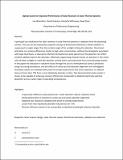| dc.contributor.author | Weinstein, Lee Adragon | |
| dc.contributor.author | Kraemer, Daniel | |
| dc.contributor.author | McEnaney, Kenneth | |
| dc.contributor.author | Chen, Gang | |
| dc.date.accessioned | 2016-10-14T18:44:42Z | |
| dc.date.available | 2016-10-14T18:44:42Z | |
| dc.date.issued | 2014-07 | |
| dc.date.submitted | 2014-06 | |
| dc.identifier.issn | 0038092X | |
| dc.identifier.uri | http://hdl.handle.net/1721.1/104836 | |
| dc.description.abstract | A principal loss mechanism for solar receivers in solar-thermal systems is radiation from the absorbing surface. This loss can be reduced by using the concept of directional selectivity in which radiation is suppressed at angles larger than the incident angle of the sunlight striking the absorber. Directional selectivity can achieve efficiencies similar to high solar concentration, without the drawbacks associated with large heat fluxes. A specularly reflective hemispherical cavity placed over the absorber can reflect emitted radiation back to the absorber, effectively suppressing emission losses. An aperture in the cavity will still allow sunlight to reach the absorber surface when used with point focus concentrating systems. In this paper the reduction in radiative losses through the use of a hemispherical cavity is predicted using ray tracing simulations, and the effects of cavity size and absorber alignment are investigated. Simulated results are validated with proof of concept experiments that show reductions in radiative losses of more than 75% from a near blackbody absorber surface. The demonstrated cavity system is shown to be capable of achieving receiver efficiencies comparable to idealized spectrally selective absorbers across a wide range of operating temperatures. | en_US |
| dc.description.sponsorship | United States. Dept. of Energy (“Concentrated Solar Thermoelectric Power”, a DOE SunShot CSP Grant, under award number DE-EE0005806) | en_US |
| dc.language.iso | en_US | |
| dc.publisher | Elsevier | en_US |
| dc.relation.isversionof | http://dx.doi.org/10.1016/j.solener.2014.06.023 | en_US |
| dc.rights | Creative Commons Attribution-NonCommercial-NoDerivs License | en_US |
| dc.rights.uri | http://creativecommons.org/licenses/by-nc-nd/4.0/ | en_US |
| dc.source | Prof. Gang Chen | en_US |
| dc.title | Optical cavity for improved performance of solar receivers in solar-thermal systems | en_US |
| dc.type | Article | en_US |
| dc.identifier.citation | Weinstein, Lee, Daniel Kraemer, Kenneth McEnaney, and Gang Chen. “Optical Cavity for Improved Performance of Solar Receivers in Solar-Thermal Systems.” Solar Energy 108 (October 2014): 69–79. | en_US |
| dc.contributor.department | Massachusetts Institute of Technology. Department of Mechanical Engineering | en_US |
| dc.contributor.approver | Chen, Gang | en_US |
| dc.contributor.mitauthor | Weinstein, Lee Adragon | |
| dc.contributor.mitauthor | Kraemer, Daniel | |
| dc.contributor.mitauthor | McEnaney, Kenneth | |
| dc.contributor.mitauthor | Chen, Gang | |
| dc.relation.journal | Solar Energy | en_US |
| dc.eprint.version | Author's final manuscript | en_US |
| dc.type.uri | http://purl.org/eprint/type/JournalArticle | en_US |
| eprint.status | http://purl.org/eprint/status/PeerReviewed | en_US |
| dspace.orderedauthors | Weinstein, Lee; Kraemer, Daniel; McEnaney, Kenneth; Chen, Gang | en_US |
| dspace.embargo.terms | N | en_US |
| dc.identifier.orcid | https://orcid.org/0000-0001-8917-7547 | |
| dc.identifier.orcid | https://orcid.org/0000-0002-3968-8530 | |
| mit.license | PUBLISHER_CC | en_US |
